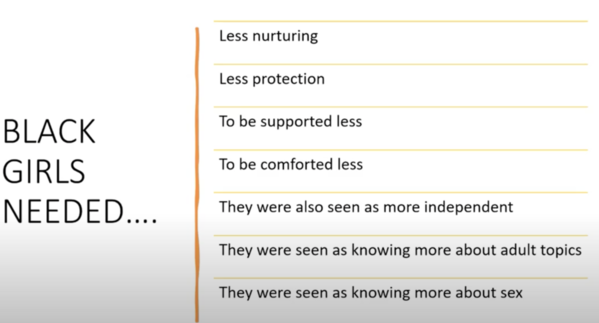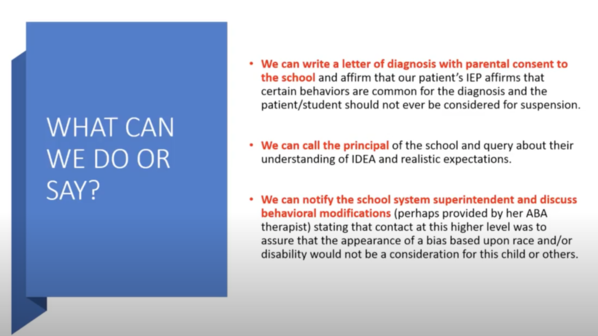The circumstances were already tragic. The parents of a three-year-old dying from hydranencephaly, a fatal condition marked by abnormal brain development, had requested one final consultation with a neurosurgeon.
Dr. Sharon Cooper, a developmental, behavioral and forensic pediatrician who accompanied them to the appointment, recalled the horror she felt at the words the neurosurgeon, who was White, blithely said to the child’s parents who were Black, when he viewed the CT scan of the child’s brain:
“The physician pointed to the brain study and stated: ‘This is exactly what an alligator brain looks like, how amazing!’ The parents were aghast and I will never forget the look in their eyes when they turned to me and said, ‘Why did you bring us here? We want to leave right now!’”
Cooper, who is Black, used the example as a springboard for a webinar she led in which she encouraged healthcare providers to be anti-racist activists advocating for their patients. She discussed what they must learn to fulfill that role, as well as how structural racism has been embedded in medicine, education, and other institutions, and how it contributes to intergenerational trauma. The webinar, organized by the California ACEs Academy, took place on May 27, 2021.
The child she mentioned in her example died a couple of hours after the neurosurgeon made that callous observation. The parents, said Cooper, “cannot accept our consolation for the wonderful parents they had been to their beloved son, because of the dehumanizing experience at the end of his young life, an experience that the parents felt certain occurred because of the color of their skin.”
“So, what can we do or say to be anti-racist in this situation, one that clearly was an example of explicit racial bias?” asked Cooper, an adjunct associate professor in the Department of Pediatrics at the University of North Carolina School of Medicine at Chapel Hill and the CEO of Developmental and Forensic Pediatrics. Cooper suggested these actions when witnessing such behavior by a colleague:
- Apologize to the family.
- Offer to write a letter to the offending clinician and hospital administrators about how wounding the experience was. (It validates the families right to feeling righteously indignant.)
- Offer a follow up visit with the family.
- Provide the family with grief support services.
- Express righteous indignation about the behavior. (Not speaking up is akin to tacitly accepting it.)
While the case of the family provides one example of explicit racial bias, Cooper summarized some of the other ways that systemic racism affects patients, families, youth and society. Racism, whether it’s explicit or internalized, she said, harms children by contributing to toxic stress, even in utero.
“We now know that that there are higher incidences of neurodevelopmental conditions that have been caused by maternal anxiety and despair and depression during pregnancy,” she said. Another sobering statistic she mentioned was the death toll for Black women during pregnancy or childbirth. They are 243% more likely to die in childbirth or pregnancy than White women, said Cooper.
“And it doesn't have anything to do with education or socioeconomic status,” she explained. “College-educated Black women have worse birth outcomes, infant mortality, lower birth weights and [are more likely to] die in childbirth than White women who have not finished high school.”
In what Cooper described as the “adultification” of Black girls, she referred to the Girlhood Interrupted Study by Georgetown University School of Law, which found that adults surveyed thought that Black girls were less innocent and more adult like than White girls between the ages of five and 14.
The adults surveyed for the study were all school-based personnel: school-based police officers, also known as school resource officers, teachers and principals. Such beliefs, said Cooper, “makes the expectations in educational settings inappropriately high for these girls.” Of all suspensions nationally, said Cooper, Black girls were suspended from school five times more frequently than White girls, according to the Girlhood Interrupted report.
Cooper, who serves on the boards of many national and international organizations fighting maltreatment against children, has seen how a racist bias has played out among her young patients.
“This [happened to] one of my patients who was a five-year-old, a very gifted child who was a very high-functioning autistic child. It was her first time in kindergarten, and she became overwhelmed by so many children in the classroom and climbed underneath her desk. And because she climbed underneath her desk, they suspended her.”
The mother of the child, who attended the webinar, talked about how the suspension affected her and her child. “It was devastating, actually. And then it was even more devastating when she started speaking of herself as bad because she felt like she was so bad that she had to be taken out of school. And it took a lot to repair all that,” the child’s mother said.
To advocate for such a patient, Cooper recommended the following:
The story of the five-year-old’s suspension based on behavior the school didn’t accept reflects a larger societal problem about racism: the tendency to respond to behavior without examining what’s driving it.
“We don't understand that acting out could represent the kind of reaction that a person with post-traumatic stress disorder frequently has when they feel threatened,” said Cooper. “If you have a teenager who has PTSD, and they are approached too aggressively by someone else, they may have intrusive thoughts. And this may cause them to react in a manner that looks as if they're highly afraid, perhaps even maybe threatening to someone else.”
In this context, Cooper described the killing by police of 16-year-old Black teenager Ma’Khia Bryant in Columbus, Ohio, after Bryant was threatening two girls with a knife.
“None of us knew that this was a foster care home that she was in,” said Cooper. “None of us knew that she was a straight A student. And none of us knew what really was bringing about her feeling the need to have to have a knife out in front of the house, when the police drove up and shot and killed her.”
Cooper highlighted data that show some of the untold stories of trauma experienced by systems-involved girls. Some 31% of girls in the juvenile justice system report having been sexually abused; 45% have 5 or more adverse childhood experiences. Around 7% of boys in the juvenile justice system have been sexually abused and 24% have 5 or more ACEs.
The term ACEs, or adverse childhood experiences, comes from the landmark Centers for Disease Control and Prevention/Kaiser Permanente Adverse Childhood Experiences Study, which tied 10 types of childhood trauma —such as experiencing physical, emotional, or sexual abuse — with greater risks of substance use and other coping behaviors and health problems in adulthood.
The study, which looked at 17,000 adults, found that ACEs were remarkably common, with most people reporting at least one ACE. People who have four or more different types of ACEs —about 12 percent of the population—have a 460 percent higher risk of depression and a 700 percent higher risk of becoming an alcoholic, compared with people who have no ACEs. (PACEs Science 101; Got Your ACE/Resilience Score?)
Cooper, who served on the Defending Children’s Taskforce organized by former U.S. Attorney General Eric Holder who served in the Obama Administration, said that kids of color are disproportionately represented in the juvenile justice system. Minority youth represent 60% of the kids who are in youth prisons in the United States, facilities that experts from the Annie E. Casey Foundationtold the taskforce, according to Cooper, should be closed, “because their research has shown that there was more violence in youth prisons than there were in adult prisons,” said Cooper.
In her work in forensic pediatrics, Cooper discussed a case that illustrated how children, especially Black children, could be criminalized unless a pediatrician steps in. The case involved a 13-year-old boy whose father brought him to the emergency room with his young brother after the younger brother disclosed that the 13-year-old brother had him lick his genitals and tried to penetrate him anally but stopped when the younger brother said it hurt. Cooper was called into investigate.
When she saw the 13-year-old in a hospital waiting room, SpongeBob was on the television and the boy’s face lit up and he was enthralled. “And he said, ‘It's my favorite program. I've been looking at it for five or six years.’ And this for me as a developmental and behavioral pediatrician struck a note that this is not normal for 13-year-old.” Later that afternoon police arrested the boy. Cooper talked with the parents and asked them if she could perform an extensive evaluation. The father also said that he had found the boy watching pornography on his cellphone. The parents agreed to the evaluation, not wanting their Black child to be criminalized, and let Cooper know that his behavior over time had grown increasingly odd. Cooper spent 90 minutes talking to the boy.
“He clearly had lost touch with reality,” she said. “He described himself under different names. He occasionally talked towards the ceiling. He also spoke with different accents. And he frequently wasn’t answering the questions I was asking him. He was, however, talking the language of many of the characters in the video games he had been playing for over four years, and a concern for schizophrenia entered into the differential diagnosis for this young boy.” Cooper found an children’s inpatient program, where the boy’s schizophrenia diagnosis was confirmed.
“I sent a letter to the court regarding his diagnosis and asking the court to consider him unable to have made a meaningful decision about his actions, and the charges were dismissed,” said Cooper. “I often tell my patients and the residents and interns that I work with, the pen is mightier than the sword and if you put it in writing it takes on a life of its own.”
While writing on behalf of patients is one way that Cooper advocates for her patients, she also finds that direct action through phone calls can make a difference. Despite prescribing 20 hours of therapy for one of her young Black patients with autism, the girl’s parent reported that she was told that the child would only be getting four hours of therapy a week. Cooper called and got straight to the point: “Is there something about this child that made you decide that you needed to decrease her therapy against what I ordered?” she asked. “That will really put people on the spot and make them think about it.”
Reflecting on the benefits of putting anti-racism into action, Cooper said, “it will bring us to a higher level, our patients will appreciate us, and we will feel better about ourselves and what we are doing, as we all try to get past the adverse childhood experiences of racism.”
Check back here the week of June 21 for a recording of the entire webinar.





Comments (0)